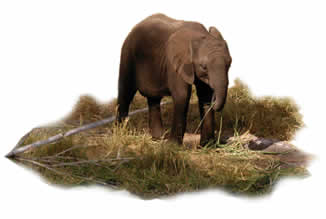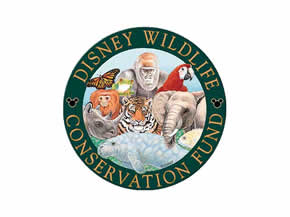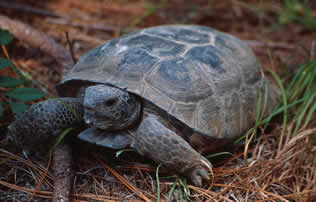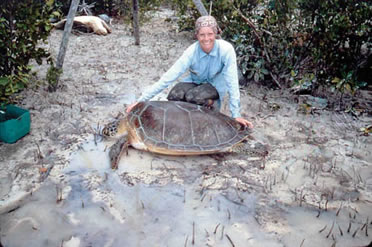|
|
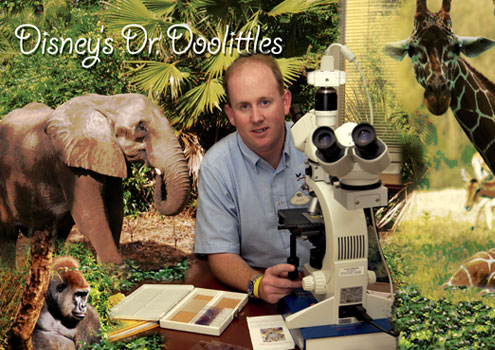 University of Florida Veterinarians Work Closely with Their Colleagues at Walt Disney World to Develop Treatments for Park Animals and Their Wild CounterpartsBy Sarah Carey downloadable pdf UF College of Veterinary Medicine faculty and students collaborate regularly with their colleagues at Animal Kingdom and throughout the Walt Disney World Resort on research projects that benefit the park’s inhabitants and their wild counterparts. “Our strong contacts at UF allow us here at Disney to provide the best possible animal care,” says Scott Terrell, a 1997 graduate of the UF veterinary college who now serves as chief veterinary pathologist at Animal Kingdom. “If we have a problem that someone at UF can help us with, I can pick up the phone and usually get a quick response or an offer of help.” Conversely, Animal Kingdom is a working laboratory for UF veterinary students, post-doctoral researchers and faculty. In addition to thousands of animals at Animal Kingdom and the other areas around the resort, such as the Living Seas at Epcot, one third of Walt Disney World is designated as permanent conservation area, hosting a variety of native Florida wildlife, including protected species such as Gopher tortoises and wood storks. Beyond Walt Disney World, the Disney Wildlife Conservation Fund has contributed more than $7 million toward some 300 projects in 30 countries since it was established in 1995. The fund and the company have awarded more than $2 million to the University of Florida for projects ranging from understanding the relationship between beach renourishment and sea turtle hatching success to evaluating human-elephant conflict in Kenya.
“After a year here, I decided I wanted to stay, and my Disney bosses decided they wanted to keep me,” Terrell says. Dr. Jackie Ogden, director of animal programs for Walt Disney World, says Terrell brings “a tremendous amount of expertise and experience” to Disney’s Animal Kingdom. When alligators started dying in Lake Griffin, Disney’s veterinary team collaborated with researchers from UF’s departments of wildlife conservation and zoology and the Florida Fish and Wildlife Conservation Commission to identify the reason. “We were able to provide pathology consultation to the team, and they now believe the die-off may have been the result of thiamine deficiency causing brain lesions,” Terrell says. “To date, we’ve examined several hundred skin biopsies looking for the parasites and documenting the pathology in the skin associated with this particular infection,” Terrell says of the project being conducted in partnership with FFWC veterinarian Dr. Mark Cunningham, a UF graduate. In South Africa, Terrell says, “We are trying to develop a network in cooperation with private and governmental organizations whereby biological samples from endangered or threatened species may be archived for long-term study or disease diagnostics. These samples may prove valuable for conservation work, or may prove useful in investigating disease outbreaks in captive animals or in the wild.” Sometimes conservation problems result when there are too many animals, rather than too few. This is the case for many populations of African elephants. Dr. Mats Troedsson, assistant professor and chief of the College of Veterinary Medicine’s theriogenology service, worked with a Disney group to develop a contraceptive program for female elephants — a field method for surgically removing their ovaries using endoscopy techniques. “Dr. Mark Stetter (Disney’s chief veterinarian) and his group have used a technique developed in our equine research program to remove ovaries from elephants in the field in Africa,” Troedsson says. On the island of Guam, researchers are working to protect the Guam Rail, a bird that is extinct in the wild but has been bred successfully in captivity. “We have performed health evaluations on the captive breeding population and on the most numerous bird on the island, the domestic chicken, to determine disease issues that could impact the breeding birds,” Terrell says. “The captive breeding population of birds in Guam is thriving, and we hope to soon have a new population of birds reintroduced on a neighboring island.” Walt Disney World is also serving as a working laboratory for many UF veterinary students and residents, including Mike Schlegel and Maud Lafortune. Schlegel, who holds a doctorate in animal science from Michigan State University and formerly worked as an associate nutritionist at the San Diego Zoo, studies the nutritional needs of more than 1,500 birds, mammals, reptiles and amphibians representing 300 species, plus 5,000 fish representing 50 species, and another 1,500 invertebrates. The Animal Nutrition Center looks like a cross between a florist and a cafeteria. Nutritionists prepare special diets using just about every fruit and vegetable imaginable, while landscapers draw from huge supplies of palm fronds, acacia, ficus and bamboo for animals to play with and for ambiance. “Depending on the animal, they’ll get a different diet every day. Their basic diet is the same, but they’ll have some variety built in,” says Schlegel, who is currently performing a post-doctoral fellowship through UF’s animal science department.
Brian Lamkin, Diet Keeper “It’s important to publish the data we’re getting,” he explains. “Our goal is to better understand the nutritional requirements of exotic animals, and to improve our nutritional husbandry.” One recent morning, zoo animal veterinarian Maud Lafortune examined a baby American alligator while park guests looked on. Like Terrell, Lafortune completed a residency in her specialty areas at UF’s College of Veterinary Medicine. Both are considered faculty members at UF as well as full-time Disney employees. Lafortune is part of a UF program through which a fourth year of clinical work at Disney follows the third year of residency in wildlife and zoo medicine. She soon will leave Orlando for a job at the Houston Zoo. Her predecessors, veterinarians Brad Locke and Geoff Pye, now work at the Atlanta and San Diego zoos, respectively, and Greg Fleming works at Animal Kingdom. Terrell, who visits Gainesville several times a month, integrates case examples from Disney into his general pathology lectures for UF veterinary students. “It’s great to emphasize the comparative pathology when you are talking about diseases that are shared by dogs, cats and perhaps even elephants,” Terrell says. A few more examples of these collegial relationships with the veterinary college include Disney’s interactions with Dr. Patrick Colahan, professor of equine surgery, and Dr. Carlos Romero, a college virologist, among others. “Dr. Colahan has helped a lot with horses that are used in parades and trail rides, and Dr. Romero has assisted us in diagnosing viral diseases in some of our birds,” Terrell says. “Establishing this type of baseline data is extremely important because it allows biologists to track trends in animal populations over time,” says Alison Styring, a biologist who heads up Disney’s wildlife monitoring program. She adds that Disney is partnering with UF researchers to monitor butterflies and gopher tortoises in the conservation areas. Researchers from UF’s McGuire Center for Lepidoptera Research are currently training Disney employees in butterfly identification techniques as part of efforts to monitor butterflies in the conservation areas. “The data we collect are integrated into a database that will monitor large-scale population trends in butterflies around the state,” Styring says. Dr. Ellis Greiner, a UF veterinary parasitologist, has had many occasions to interact with the Disney group, as has Dr. Marilyn Spalding, an associate scientist whose expertise is in whooping crane research. “Studies resulting from Scott (Terrell) finding parasites in animals from many places around the world is an avenue ripe for collaboration,” Greiner says. “We see a lot of interesting and unusual cases that folks up there in Gainesville don’t get exposure to,” Terrell adds.
Scott P. Terrell
Recent UF Projects Funded by the Beach Nourishment and Sea TurtlesMario Mota, doctoral candidate, Department of Wildlife Ecology and Conservation
Emerging Infections of Tortoises and TurtlesElliott Jacobson, professor of zoological medicine Evaluating Human-Elephant Conflict InterventionsChristine Browne-Nunez, doctoral candidate, Department of Wildlife Ecology and Conservation Project Shark AwarenessGeorge Burgess, director of the International Shark Attack File, Florida Museum of Natural History
Targets for Green Turtle RecoveryKaren Bjorndal, director of the Archie Carr Center for Sea Turtle Research |
